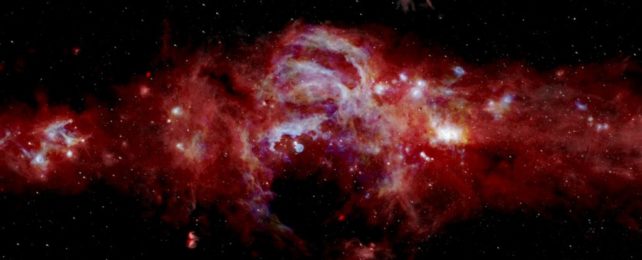The galactic center is basically the Wild West of the Milky Way. Dominated by a supermassive black hole 4.3 million times the mass of the Sun, the environment is the most hostile in the galaxy.
Black holes, as we know, are where stars risk certain death. Stars that venture too close to one can be teased into streamers of gas and dust by the extreme tidal forces, ending what could have been a long and productive life fusing atoms.
Imagine the surprise astronomers felt when they found the opposite – a star not dying but in the process of being born right near the Milky Way's own monstrous maw, Sagittarius A* (Sgr A*).
X3a, as this new cosmic object is known, is just a few tens of thousands of years old, barely an eyeblink in cosmic time. Yet it sits so close to Sgr A* that its very presence challenges our understanding of not just star formation but the operations of black holes.
Despite the dynamic intensity and powerful UV and X-radiation that would prevent gas from coalescing into the seed of a star, X3a not just exists but does so in a place where no baby star is expected to form.
At 10 times the radius, 15 times the mass, and 24,000 times the luminosity of the Sun, it's not exactly a petite infant star either.
According to a team led by astrophysicist Florian Peißker of the University of Cologne in Germany, the reason is relatively simple. X3a didn't form where it is: It formed farther from the black hole and migrated inwards.
"It turns out that there is a region at a distance of a few light years from the black hole which fulfills the conditions for star formation," Peißker explains. "This region, a ring of gas and dust, is sufficiently cold and shielded against destructive radiation."
The specifics of star formation are still something of a mystery, but we know that certain conditions need to be met. A star forms in a dense, cold molecular cloud in space, when a denser clump collapses, spinning, under its own gravity and starts to gravitationally attract more material from the cloud around it.
The immediate vicinity of a supermassive black hole is not considered a particularly good environment for these conditions. Sgr A* is surrounded by a disk of dust and gas known as an accretion disk, swirling around at high speeds and emitting intense light. Ultraviolet photons exert radiation pressure and photoevaporation processes that can curtail star formation and accretion disks emit a lot of it.
Beyond a certain distance from the black hole, the material is thick enough to protect against these destructive influences and keep temperatures cool enough for star formation.
According to the team's analysis, X3a could have formed in this region, a ring of material around the galactic center. In this ring, a denser cloud could have come together, generating enough mass in a small enough area for the gravitational collapse that starts the star formation process.
This cloud started with a mass of about 100 Suns, and its gravitational collapse could have triggered the formation of several baby stars.
But X3a didn't stay put. It started migrating in towards Sgr A*, still surrounded by material as it grew. On the way, it could have encountered other dense clumps and clouds that formed in the same environment, allowing the baby star to accumulate even more mass. It's still in that growth phase now, surrounded by material.
It's that blob of material, named X3, that first caught astronomers' attention, before they identified the baby star inside. Multiple infrared and near-infrared instruments could discern the long-wavelength light of the star that could penetrate the thick cloud envelope around it. Analysis of this light revealed chemistry consistent with a baby star.
"With its high mass of about ten times the solar mass, X3a is a giant among stars, and these giants evolve very quickly towards maturity," says astronomer Michal Zajaček at Masaryk University in Czechia.
"We have been lucky to spot the massive star in the midst of the comet-shaped circumstellar envelope. Subsequently, we identified key features associated with a young age, such as the compact circumstellar envelope rotating around it."
The discovery of X3a could help astronomers resolve another decades-long mystery. Around 20 years ago, very young stars were spotted in the vicinity of Sgr A*, where previously it was thought only very old stars could exist. X3a suggests that the formation of young stars farther out, followed by their migration in towards Sgr A*, might not be a particularly uncommon occurrence.
And it might not happen just in our galaxy, either. The structures around Sgr A* have been identified in many other galaxies, and they could host populations of baby stars of their own. It's a notion that could change our understanding of the dynamics of galactic nuclei.
Future work will test the team's star formation model, not just for the Milky Way but for the broader Universe.
The research has been published in The Astrophysical Journal Letters.
